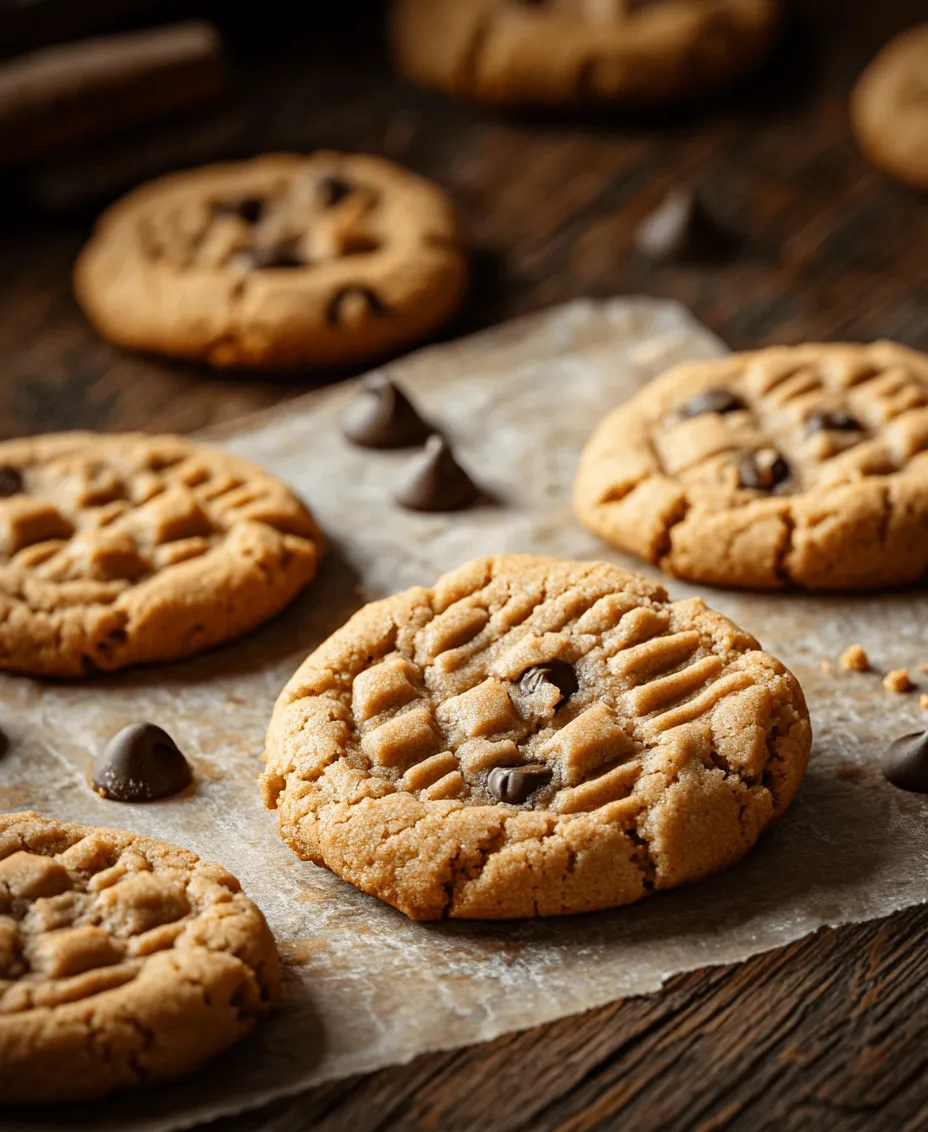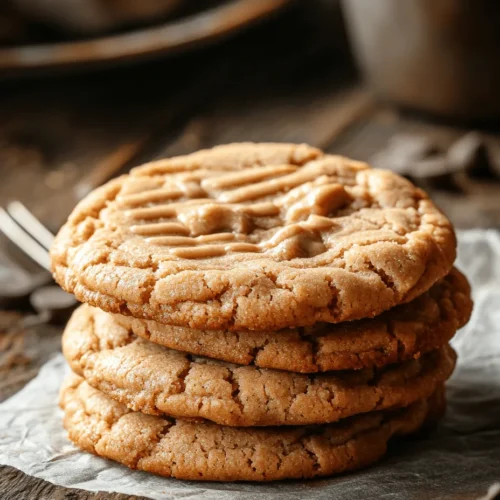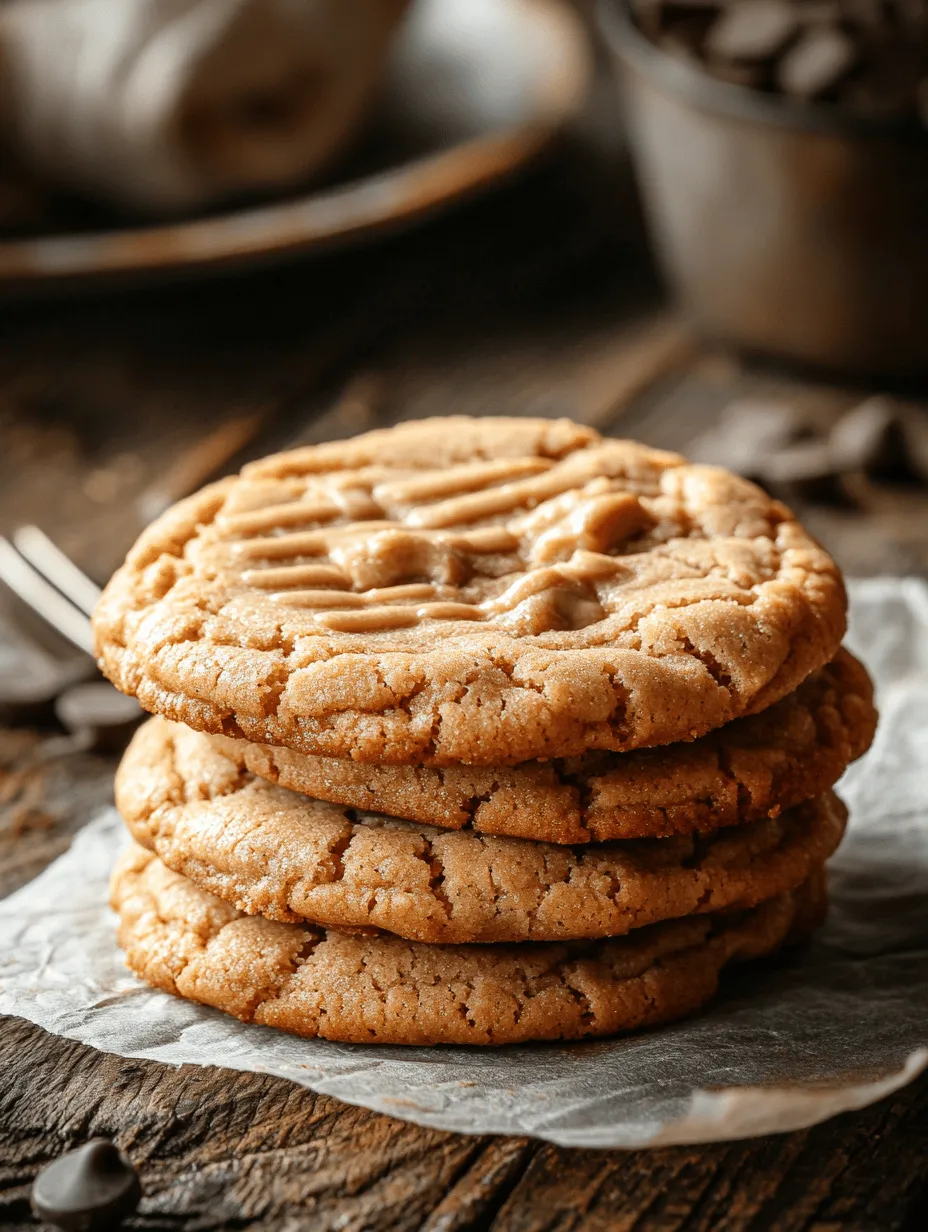Introduction
Thick and chewy peanut butter cookies are a timeless treat that combines simple ingredients with rich flavors. These delightful cookies hold a special place in the hearts of many, embodying the comforting essence of home baking. Whether you’re a lifelong fan of peanut butter or just looking for a delightful dessert to satisfy your sweet tooth, this recipe is sure to exceed your expectations. In this article, we will explore the origins of peanut butter cookies, the key ingredients that make them special, and provide a detailed step-by-step guide to creating your own batch of these delicious cookies.
The Allure of Peanut Butter Cookies
Understanding the Popularity of Peanut Butter Cookies
Peanut butter cookies have long enjoyed a beloved status among cookie enthusiasts. Their rich, nutty flavor, combined with a chewy texture, creates a mouthwatering treat that is hard to resist. But what is it about these cookies that makes them so universally adored?
Historical Background of Peanut Butter in Baking
The history of peanut butter dates back to the 19th century when it was first introduced as a source of protein. It gained popularity as a spread, but its incorporation into baking transformed the dessert landscape. By the early 1900s, peanut butter cookies began to appear in American cookbooks, marking the beginning of a delicious trend. The iconic crisscross pattern made with a fork became synonymous with these cookies, further solidifying their place in American baking culture.
Evolution of Cookie Recipes Over the Years
As baking techniques evolved, so did cookie recipes. While traditional peanut butter cookies typically featured a simple combination of peanut butter, sugar, and flour, modern adaptations have introduced a variety of flavors and textures. From adding oats to incorporating chocolate chips, the peanut butter cookie has transformed into a versatile dessert that caters to various tastes. Despite these changes, the classic thick and chewy version remains a favorite.
Why Peanut Butter Cookies Remain a Favorite
The enduring popularity of peanut butter cookies can be attributed to their nostalgic qualities. For many, these cookies evoke memories of home, family gatherings, and comforting moments. Their simplicity and the ease of preparation make them an ideal choice for both novice bakers and seasoned chefs. Additionally, the natural richness of peanut butter offers a unique flavor profile that pairs well with various ingredients, ensuring that there is a version for everyone to enjoy.
Key Ingredients for Thick and Chewy Peanut Butter Cookies
To create the perfect thick and chewy peanut butter cookies, it is essential to understand the role of each ingredient in the recipe. Let’s break down the key components that contribute to the cookies’ deliciousness.
Creamy Peanut Butter: The Heart of the Recipe
At the core of any peanut butter cookie is, of course, creamy peanut butter. This ingredient provides the distinctive nutty flavor and contributes to the cookies’ chewy texture. For the best results, choose a high-quality peanut butter that contains only peanuts and salt. Avoid natural varieties with a runny consistency, as they may affect the final texture of the cookies.
Brown Sugar vs. Granulated Sugar: What They Bring to the Table
Both brown sugar and granulated sugar play crucial roles in cookie recipes. Brown sugar contains molasses, which adds moisture and contributes to the chewy texture of the cookies. It also imparts a subtle caramel flavor that enhances the overall taste. Granulated sugar, on the other hand, helps with the spread of the cookies during baking. For the ideal balance, this recipe typically utilizes a combination of both sugars, creating a delightful depth of flavor.
The Role of Eggs in Texture and Moisture
Eggs are a vital component in cookie recipes, serving multiple purposes. They provide moisture, contribute to the structure, and help bind the ingredients together. In this recipe, one large egg is used, which helps create a tender crumb while ensuring the cookies maintain their thick and chewy profile.
Importance of Vanilla Extract for Flavor Depth
Vanilla extract is a staple in many baking recipes, and for good reason. A teaspoon of pure vanilla extract adds a rich, aromatic flavor that complements the peanut butter beautifully. It enhances the overall taste experience, making each bite more enjoyable. Opt for pure vanilla extract over imitation varieties for the best flavor.
Baking Soda: The Leavening Agent
Baking soda acts as a leavening agent, providing the lift needed for cookies to rise during baking. It reacts with the acidic components in the dough, creating carbon dioxide bubbles that contribute to a lighter texture. For thick and chewy peanut butter cookies, the right amount of baking soda is crucial to achieving the desired height without compromising the chewiness.
The Subtle Touch of Salt: Balancing Sweetness
A pinch of salt is an essential ingredient in cookie recipes, as it helps to balance the sweetness. Salt enhances the flavors of the other ingredients, making the cookies taste more complex and satisfying. It also helps to cut through the richness of the peanut butter, ensuring that each bite is perfectly balanced.
Optional Chocolate Chips: Elevating the Indulgence Factor
While thick and chewy peanut butter cookies are delicious on their own, adding chocolate chips can elevate them to a new level of indulgence. The combination of creamy peanut butter and rich chocolate creates a delightful contrast that many cookie lovers adore. If you choose to include chocolate chips, opt for semi-sweet or dark chocolate to complement the peanut butter’s nuttiness.
Step-by-Step Instructions for Perfect Cookies
Now that you understand the key ingredients that make thick and chewy peanut butter cookies so special, let’s delve into the step-by-step instructions for crafting these delightful treats. Follow these detailed guidelines to ensure success in your cookie-making adventure.
Preparation: Preheating the Oven and Gathering Materials
Before you begin mixing your ingredients, it’s crucial to prepare your kitchen. Start by preheating your oven to 350°F (175°C). This temperature is ideal for baking cookies, allowing them to rise and develop the perfect texture. While the oven heats up, gather all the materials you will need:
– Ingredients: Ensure you have all the essential ingredients measured and ready to go. This includes creamy peanut butter, brown sugar, granulated sugar, an egg, vanilla extract, baking soda, salt, and any optional chocolate chips.
– Baking Sheet: Line your baking sheet with parchment paper or a silicone baking mat to prevent the cookies from sticking and to promote even baking.
– Mixing Bowls: Have a large mixing bowl and a smaller bowl ready for combining your dry and wet ingredients separately.
– Measuring Cups and Spoons: Accurate measurements are key to successful baking, so ensure your measuring cups and spoons are on hand.
Mixing the Dough: Techniques for a Smooth Blend
Once your oven is preheated and your materials are gathered, it’s time to prepare the cookie dough. Begin by following these steps:
1. Combine the Sugars and Peanut Butter: In a large mixing bowl, use a hand mixer or a sturdy spatula to cream together the creamy peanut butter, brown sugar, and granulated sugar. Mix until the mixture is smooth and well combined. This step is crucial for incorporating air into the dough, which helps create a light texture in the final cookies.
2. Add the Egg and Vanilla: Next, add the egg and vanilla extract to the peanut butter mixture. Beat the ingredients together until fully incorporated. This will add moisture and flavor to the dough.
3. Mix Dry Ingredients: In a separate bowl, whisk together the flour, baking soda, and salt. This ensures that the leavening agent and salt are evenly distributed throughout the flour before adding it to the wet ingredients.
4. Combine Wet and Dry Ingredients: Gradually add the dry ingredients to the wet mixture, stirring until just combined. Be careful not to overmix, as this can lead to tough cookies. The dough should be thick and slightly sticky.
5. Optional Chocolate Chips: If you’re adding chocolate chips, fold them into the dough at this stage. This will ensure that the chips are evenly distributed throughout the cookie batter.
Shaping the Cookies: Tips for Ideal Scooping and Flattening
With your cookie dough ready, it’s time to shape your cookies for baking. Follow these tips to achieve the perfect cookie shape:
1. Scoop the Dough: Using a cookie scoop or a tablespoon, portion out the dough onto the prepared baking sheet. Leave enough space between each cookie, as they will spread slightly during baking.
2. Flatten the Cookies: For that iconic thick and chewy texture, gently flatten each dough ball with the back of a fork or the palm of your hand. If using a fork, create a crisscross pattern by pressing down on the dough in one direction and then again in the opposite direction.
3. Bake: Place the baking sheet in the preheated oven and bake for 10–12 minutes, or until the edges are lightly golden. The centers may appear slightly underbaked, but they will continue to firm up as they cool.
4. Cooling: Once baked, remove the cookies from the oven and let them cool on the baking sheet for about 5 minutes before transferring them to a wire rack to cool completely. This resting time allows the cookies to set and ensures they maintain their chewy texture.
By following these detailed steps, you’ll be well on your way to creating thick and chewy peanut butter cookies that are sure to impress friends and family alike. Stay tuned for the second part of this article, where we will delve deeper into tips for achieving the best results and answer some common questions about peanut butter cookies.

Baking: Achieving the Perfect Golden Edges
Baking peanut butter cookies to perfection involves more than just mixing ingredients; it’s an art that requires attention to detail. The goal is to achieve cookies with golden edges while maintaining a soft, chewy center. Preheating your oven to the correct temperature (preferably 350°F or 175°C) is crucial, as this ensures even baking.
Once your dough is ready and portioned onto a lined baking sheet, gently press down on each ball of dough to flatten them slightly. This helps the cookies spread evenly during baking. Keep a close eye on your cookies as they bake. You want them to be set around the edges but slightly soft in the center when you pull them out of the oven. Typically, this takes about 10 to 12 minutes but can vary based on your specific oven.
An excellent tip is to rotate the baking sheet halfway through the baking time to ensure that the cookies cook evenly, especially if your oven has hot spots. When the edges start to turn a light golden brown, it’s time to take them out. Remember, cookies will continue to cook slightly on the baking sheet once removed from the oven, so err on the side of slightly underbaking for that perfect chewy texture.
Cooling: Best Practices for Texture Retention
After baking, the cooling process is equally important. If you leave your cookies on the baking sheet for too long, they can become overly soft or even soggy. The ideal practice is to let them cool on the baking sheet for about 5 minutes. This allows the cookies to set while still warm, making them easier to transfer without breaking.
After the initial cooling period, carefully move the cookies to a wire rack. This step is vital as it allows air to circulate around the cookies, helping them maintain their chewy texture. If you don’t have a wire rack, placing them on a plate is fine, but be aware that they might lose some of their crispness on the bottom due to moisture buildup.
Baking Tips for the Best Peanut Butter Cookies
To elevate your peanut butter cookie experience, consider these valuable baking tips:
The Importance of Ingredient Temperature
Using ingredients at room temperature can significantly affect the texture of your cookies. For instance, when butter is softened, it incorporates air better when creamed with sugar, resulting in a lighter texture. Make sure to take your butter and eggs out of the refrigerator about 30 minutes before you start baking.
How to Avoid Overmixing the Dough
When mixing your cookie dough, it’s crucial to avoid overmixing once the flour is added. Overmixing can lead to tough cookies due to gluten development. Mix just until the flour is incorporated and the dough is uniform. This will ensure your cookies remain thick and chewy rather than hard and dry.
Checking for Doneness: Visual Cues and Timing
As mentioned earlier, the golden edges are a great visual cue for doneness. Look for cookies that are lightly browned around the edges and still soft in the center. If you’re unsure, you can also use a toothpick to check; it should come out with a few moist crumbs but not wet batter.
Storing Cookies for Freshness and Longevity
To keep your cookies fresh, store them in an airtight container at room temperature. They can last up to a week this way. If you want to extend their shelf life, consider freezing them. Place cooled cookies in a single layer on a baking sheet, freeze until solid, then transfer to a freezer-safe bag or container. They can be enjoyed straight from the freezer or thawed at room temperature.
Variations on the Classic Recipe
While the classic peanut butter cookie is undeniably delicious, there are numerous ways to put a creative spin on this beloved treat.
Swapping Peanut Butter for Almond or Cashew Butter
For those who enjoy a different nutty flavor, try substituting peanut butter with almond or cashew butter. Each nut butter provides a unique taste and texture, while still delivering that satisfying chewiness. Just ensure that the nut butter you choose has a similar consistency to peanut butter for the best results.
Introducing Spices for a Unique Flavor Profile
Adding spices can greatly enhance the flavor of your cookies. Consider incorporating cinnamon, nutmeg, or even a pinch of cayenne pepper for a hint of warmth. These spices can complement the nutty flavor of the peanut butter and create a more complex taste.
Creating Stuffed Cookies: Filling Ideas
For cookie lovers who crave something extra, stuffed cookies are an exciting option. You can stuff your peanut butter cookies with chocolate chips, caramel, or even a dollop of jam before baking. Simply flatten a portion of cookie dough, add a teaspoon of your chosen filling, and cover it with another layer of dough before baking.
Gluten-Free Alternatives: How to Adjust the Recipe
If you or someone you know has gluten sensitivities, you can easily convert this recipe into a gluten-free version. Substitute all-purpose flour with a gluten-free flour blend. The texture may vary slightly, so you might need to experiment a bit to find the right blend that works for your taste and texture preferences.
Nutritional Information
Understanding the nutritional aspects of your peanut butter cookies can help you enjoy them mindfully.
Caloric Breakdown Per Cookie
Each thick and chewy peanut butter cookie contains roughly 100 to 120 calories, depending on the size and ingredients used. This makes them a delicious treat that can be enjoyed without feeling guilty.
Nutritional Benefits of Peanut Butter
Peanut butter is not only delicious; it also boasts several health benefits. It is an excellent source of protein, healthy fats, and various vitamins and minerals, including magnesium, vitamin E, and B vitamins. These nutrients can contribute to your overall health, making peanut butter a smart addition to your diet when consumed in moderation.
Balancing Indulgence with Mindful Eating
While these cookies are a delightful indulgence, it’s essential to practice mindful eating. Enjoying a cookie or two as part of a balanced diet allows you to savor the delicious flavors without overindulging. Pairing your cookies with fresh fruit or a glass of milk can also enhance the experience while adding nutritional value.
Conclusion
Thick and chewy peanut butter cookies are not just a dessert; they are a nostalgic experience that brings comfort and joy. By following this recipe and understanding the ingredients and processes involved, you can create a batch that will impress family and friends. Whether enjoyed fresh from the oven or stored for later, these cookies embody the perfect combination of sweetness and nutty flavor, making them a cherished addition to any dessert table.
With variations to explore and tips to enhance your baking experience, the possibilities are endless. So roll up your sleeves, gather your ingredients, and get ready to enjoy the warm, delightful aroma of homemade peanut butter cookies wafting through your kitchen. Whether you share them with loved ones or keep them all to yourself, each bite will be a delicious testament to your baking prowess.


